Against the backdrop of the COVID-19 pandemic and rising cartel fragmentation, 22 Mexican states saw improved peacefulness in 2020, with ten deteriorating.
Mexico’s peacefulness has improved by 3.5%, the country’s first positive shift on the 2021 Mexico Peace Index after four successive years of deterioration.
The story of Mexico’s improved peacefulness is best understood at the sub-national level, as the country’s 32 states see enormous disparities across key indicators.
Against the backdrop of the COVID-19 pandemic and rising cartel fragmentation, 22 Mexican states saw improved peacefulness in 2020, with ten deteriorating.
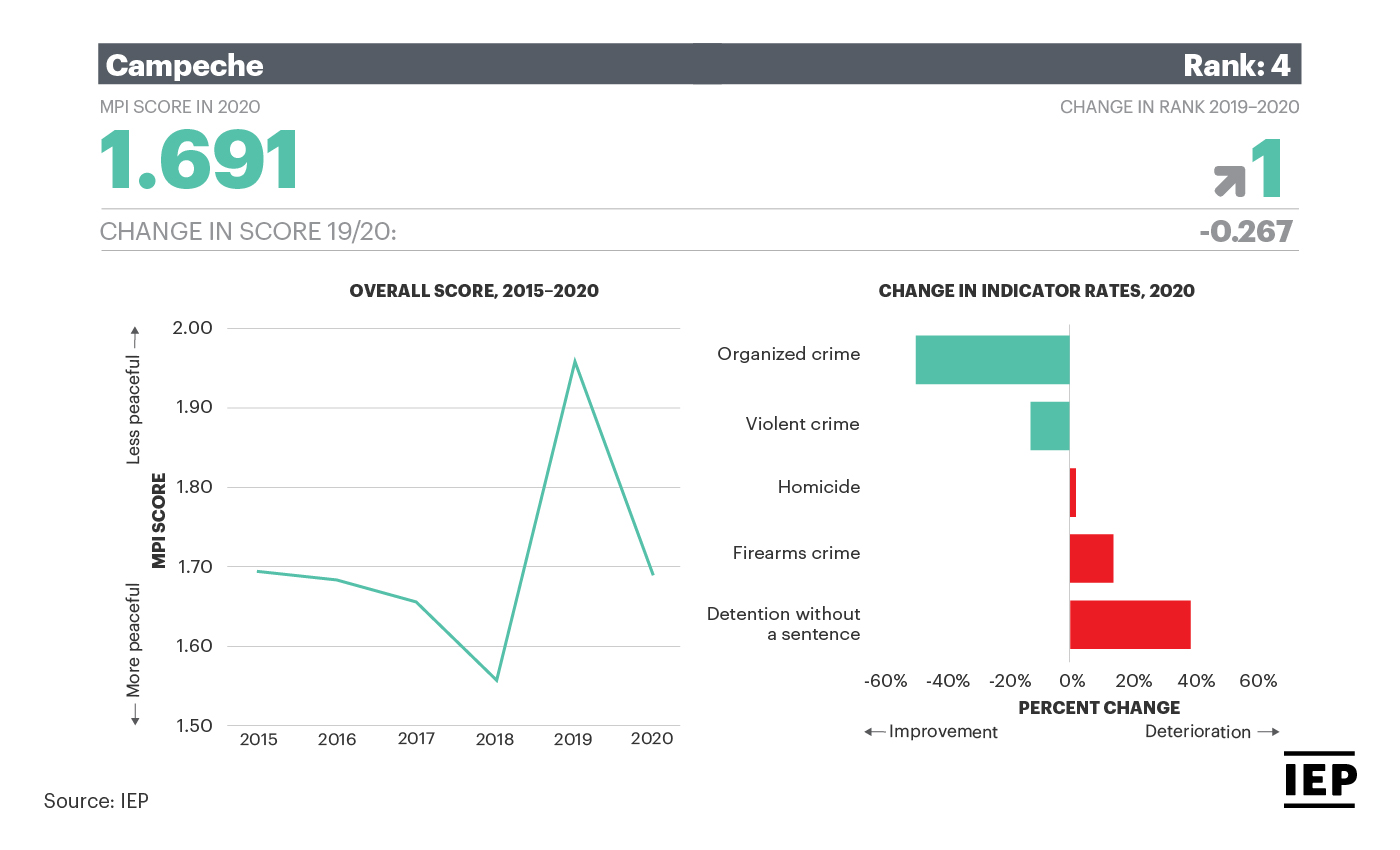
With an overall MPI rank of 4th place, Campeche is consistently listed as one of Mexico’s most peaceful states.
Located on the tip of Mexico’s Yucatán Peninsula, the state saw a 50.5% reduction in its organised crime rate in 2020, the largest such improvement country-wide.
Digging into Campeche’s organised crime trends reveals two substantial improvements: the state saw a 73.8% reduction in major criminal offenses and a 75.4% drop in the rate of kidnapping and human trafficking.
In addition to improvements in rates of extortion and retail drug crime, these shifts see Campeche register the lowest organised crime rate for any state in Mexico.
Within this broader positive shift, Campeche recorded a 16.6% increase in robberies of homes and businesses, contrary to the 4.6% national improvement.
Of the five most improved Mexican states, Campeche was the only jurisdiction that failed to register a decrease in its homicide rate. However, the 1.9% increase in murders marked a significantly smaller deterioration compared to previous years.
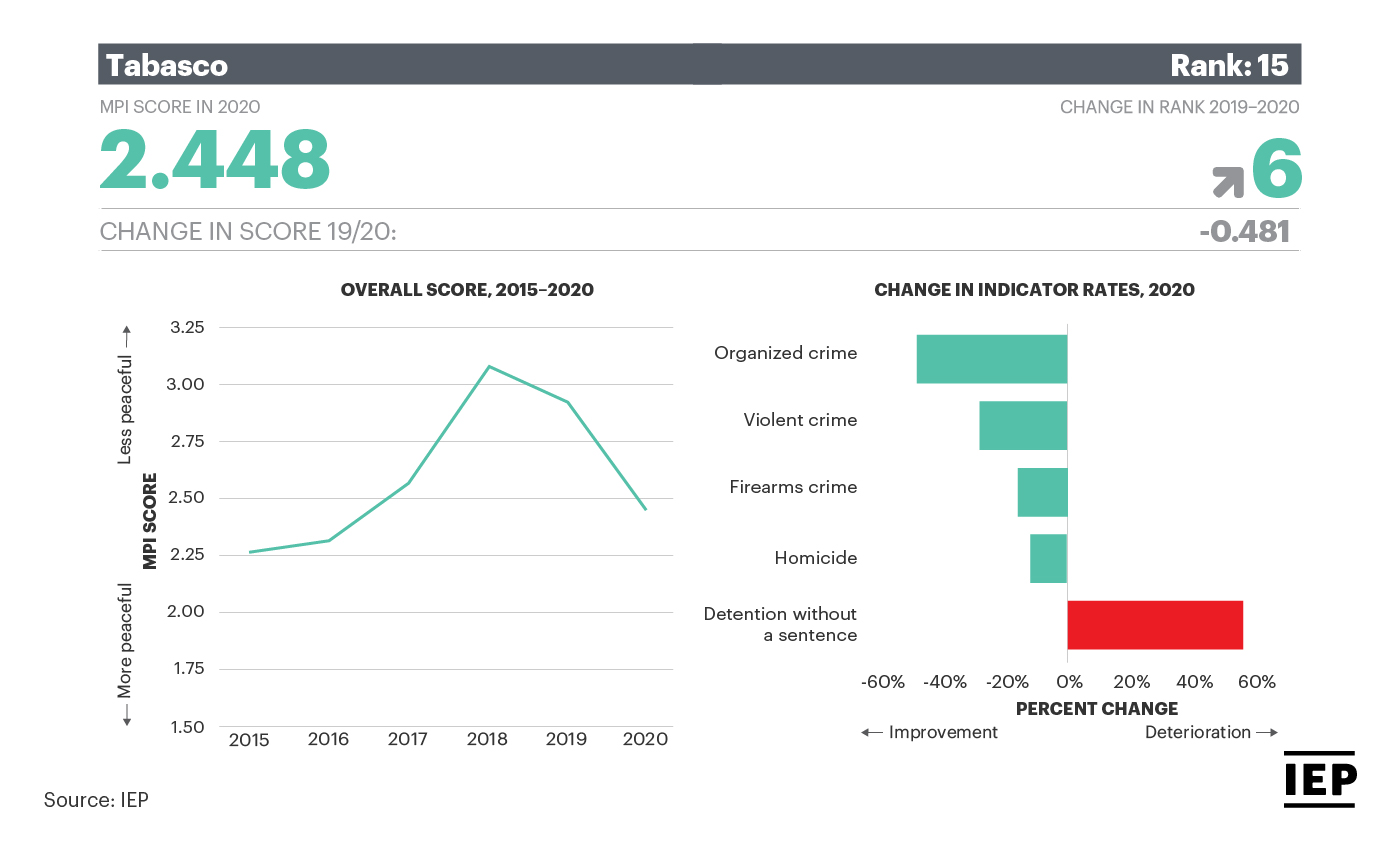
Sharing it’s eastern border with Campeche, the state of Tabasco rose to 15th place on the MPI rankings.
Driven primarily by a 49.4% improvement in its organised crime rate, Tabasco saw its MPI ranking jump six places.
Tabasco led the nationwide reversal of a four-year deterioration in homicide and firearms crimes.
Of the crimes most commonly experienced by people in Tabasco — robbery and assault in public spaces — 2020 saw notable reductions of 38.4% and 17.5% respectively.
Within the broader organised category, Tabasco also registered a 55.6%decline in extortion, a 30% decline in retail drug crime and a 20.5% decline in kidnapping and human trafficking.
The state registered the lowest incidence rate of major offences of any state, a category that includes federal drug trafficking crimes and organised criminal offenses committed by three or more people.
The long-term stability of these improvements is difficult to gauge, as a portion of these nationwide shifts can be attributed to the stay-at-home orders implemented during the peak of the COVID-19 pandemic.
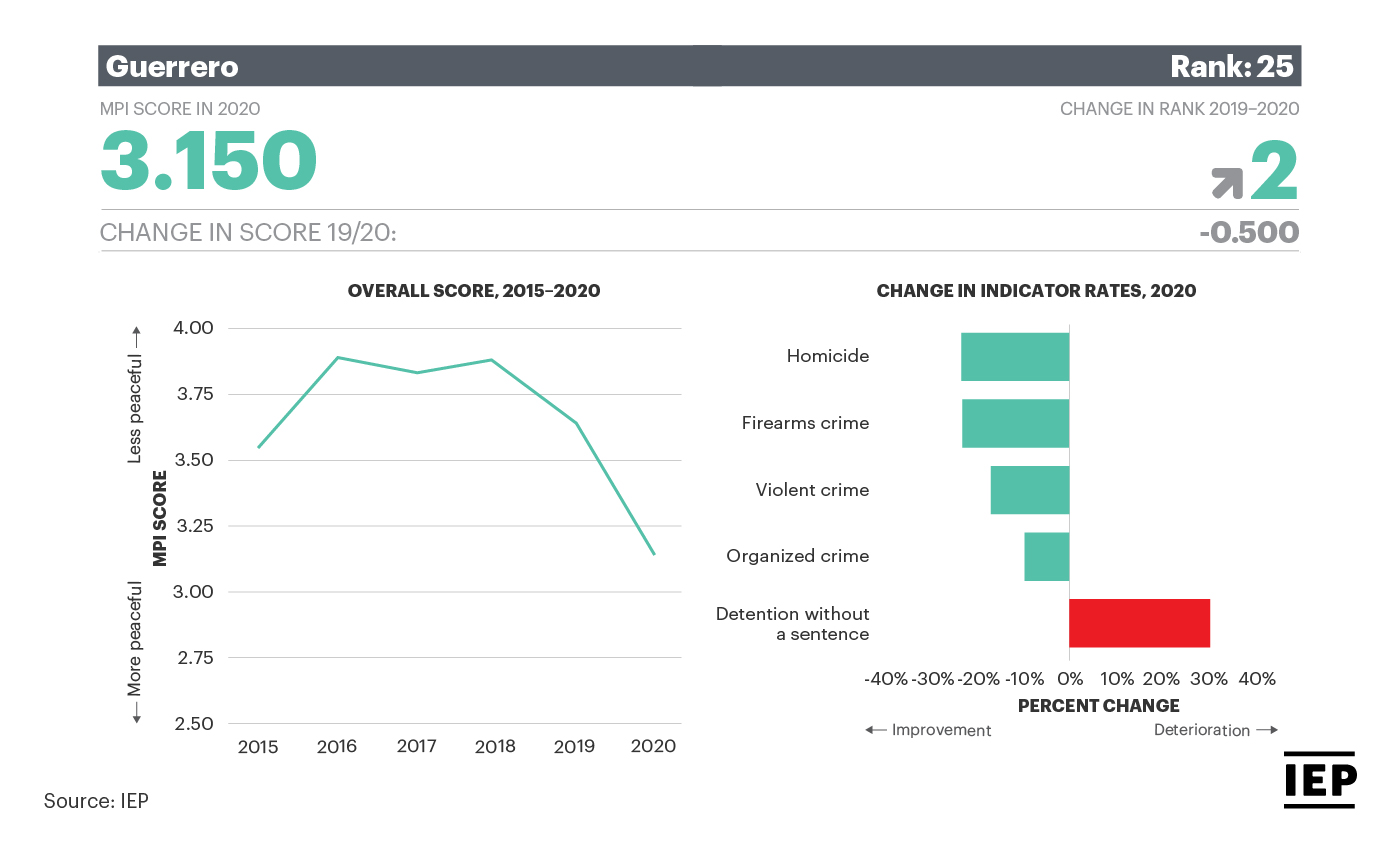
Located on Mexico’s Pacific coastline, the state of Guerrero saw its overall MPI score improve by 13.7% in 2020, driven by a substantial 23.7% reduction in its homicide rate.
This improvement is notable as Guerrero has consistently recorded one of the highest homicide rates amongst Mexican states since 2015.
Crime in Guerrero is disproportionately balanced between its cities, an imbalance primarily driven by the crime rates in the port city of Acapulco. Acapulco experiences the sixth highest homicide rate of any Mexican city, a ranking that sees it register as the seventh most violent city in the world.
Overall, Guerrero saw a 9.8% improvement in organised crime, a shift underpinned by a 12.1% reduction in extortion and a 27.3% reduction in kidnapping and human trafficking.
These trends are significant in view of the proliferation of distinct criminal groups in Guerrero over the past half-decade.
A function largely of cartel fragmentation and the state’s role as Mexico’s largest heroin producer, the state has seen the proliferation of over 40 armed groups contesting for territory.
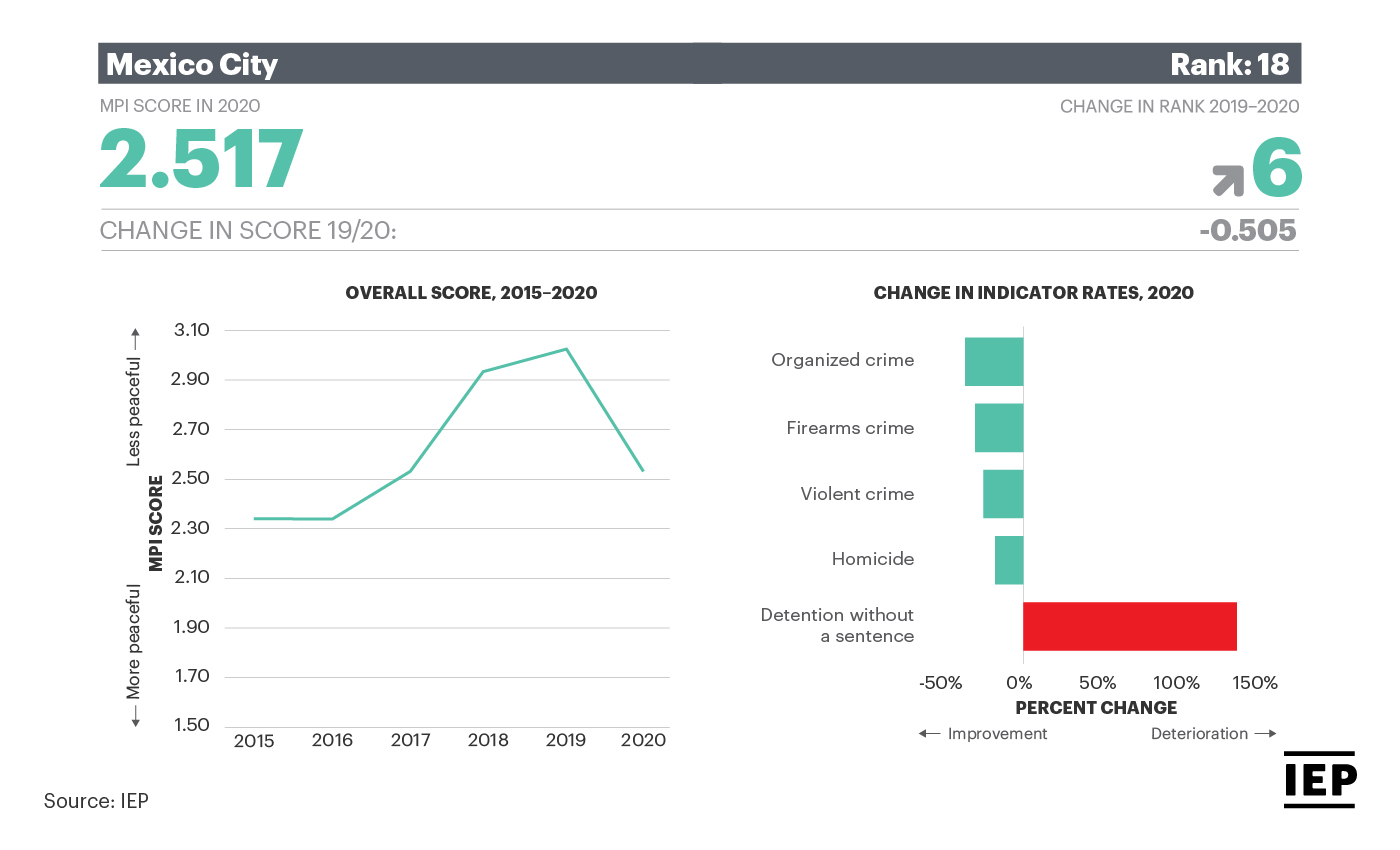
Located directly north of Guerrero, the state of Mexico City saw improvements in four of the five MPI indicators.
These positive trends saw the state jump six places to 18th in the MPI ranking.
With the exception of a 7.9% rise in family violence, Mexico City saw rates for all sub-indicators of violent crime, organised crime and firearms crime improve in 2020.
In a deterioration that mirrored a national trend, Mexico City’s women’s emergency hotline saw a 300% increase in family violence calls than in 2019.
It is argued that this deterioration, along with many of the statistical improvements seen in the state, were the result of Mexico City’s second highest stay-home rate — a figure derived from analysis of Facebook mobility data.
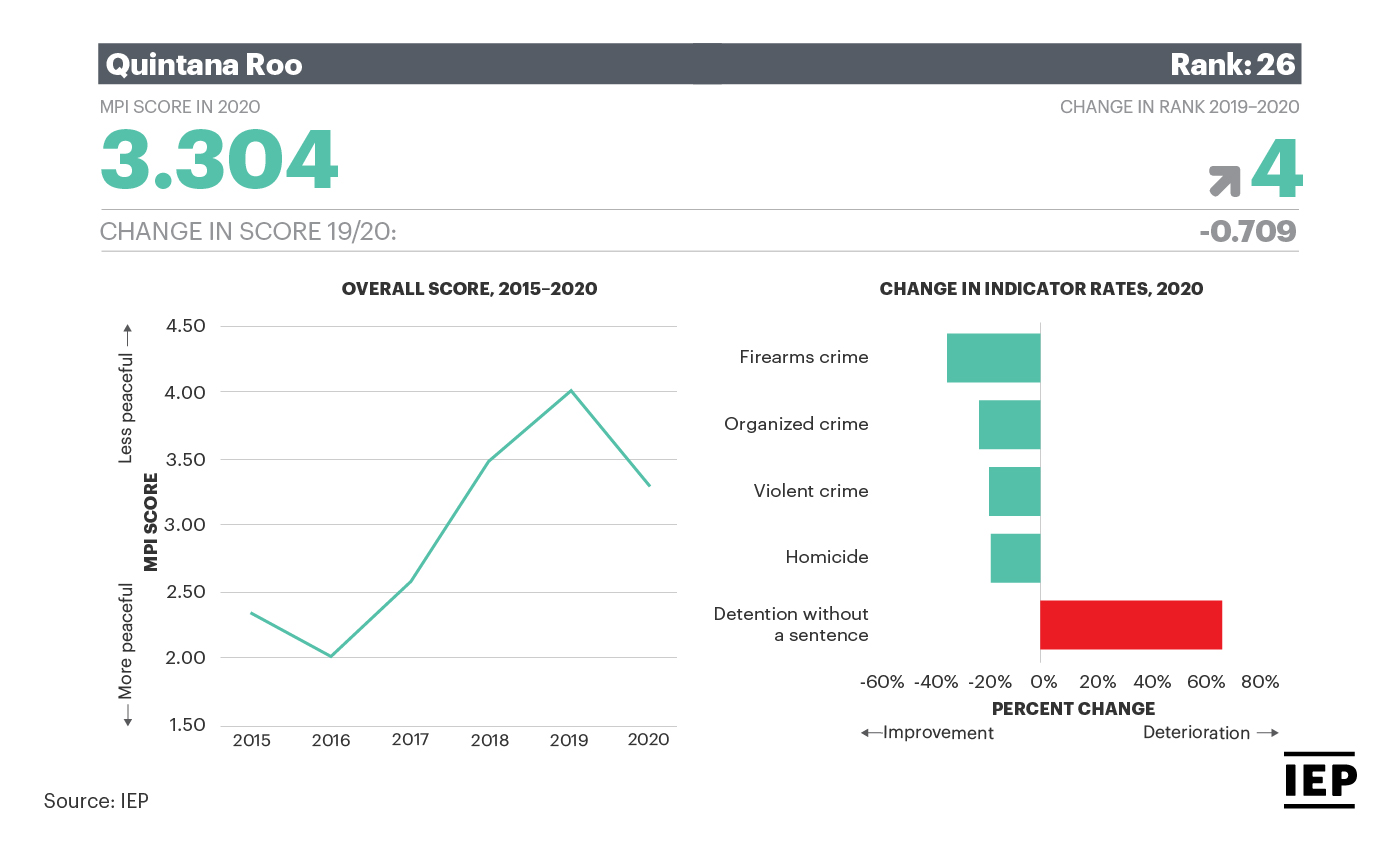
Following three years of substantial deterioration, Quintana Roo recorded the largest improvement in peacefulness of any Mexican state in 2020.
The state saw substantial improvements in four of five key peacefulness indicators, led by the largest decrease in firearms crimes seen in any Mexican state.
Quintana Roo registered a series of notable statistical trends, including a 19.2% improvement in violent crime, a 29.6 decrease in robberies and a 18.5% fall in its homicide rate.
Moving against a nation-wide deterioration, Quintana Roo also saw a 14.6% decrease in family violence, the second largest such improvement of any Mexican state.
Economic activity in Quintana Roo was severely impacted by the COVID-19 pandemic, with both legitimate and illicit activities hitting nadirs.
The state’s economy relies largely on tourism, which in the wake of travel restrictions saw revenues halve from 15.4 billion pesos in 2019 to 6.4 billion pesos in 2020.
Reduced human mobility also impacted profit-generating practices of criminal groups, with rates of extortions, kidnappings and human trafficking, retail drug crimes and major offences all dropping in 2020.
The culmination of these improvements was an overall 22.8% improvement in Quintana Roo’s organised crime rate.
Despite these positive trends, the state still ranks among the ten least peaceful Mexican states. This ranking is impacted significantly by ongoing territory conflicts between the Sinaloa and CJNG cartels.
Quintana Roo is a hotspot for cartel conflict because of its geographic proximity to the ocean, maximising the control of the state’s cities and coastline crucial for northward drug trafficking.
These dynamics have seen the state register the highest kidnapping and human trafficking rate in Mexico for two consecutive years.
Download and read the full 2021 Mexico Peace Index Report.